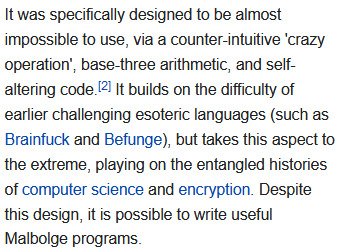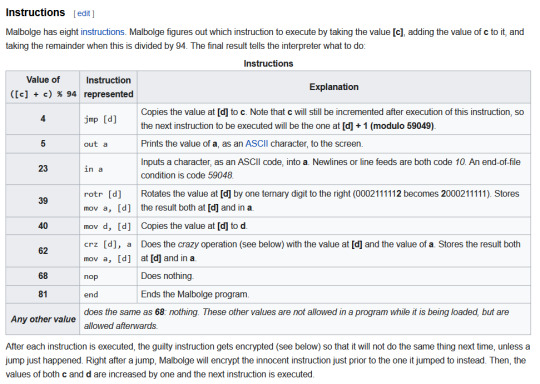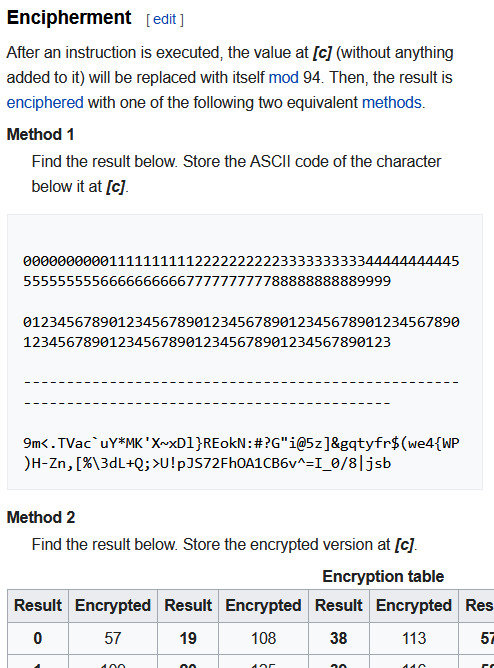#Befunge
Explore tagged Tumblr posts
Text
Currently trying to write a bubblesort algorithm in Befunge, which is pretty much the level of weird that I should've expected to be doing on the weekend before crimsas
0 notes
Text
that's 90s unfortunately
Like, I know the "multidimensional programming" line in Ghost Trick might just be intended as throwaway technobabble, but given that the setting's tech level seems to be 60s/70s there's a nonzero chance that they're just talking about nesting arrays.
90 notes
·
View notes
Note
The befung bloodline is typically are nothing but gas machine is being fed slop all day
Naaa Toph was brainwash while this world Lin and Suyin are the spoil fat twins
2 notes
·
View notes
Note
And to this day many more water tribes women disappeared due to the ghost trying to find a warm place.

Of course that disappearance of her friend and honestly her main source of food wouldn't go unnoticed for long as well as all the rumors of Water tribe women disappearing.
Eventually the blind bandit The runaway the legend herself Toph befung would investigate.
2 notes
·
View notes
Text
Top 15 Weird Programming Languages In Use in 2024
Programming languages have come a long way since the early days of computer science. While mainstream languages like C, Java, and Python continue to dominate software development, there are plenty of more obscure and unconventional options out there. These "weird" languages often prioritize things like ease of use, minimalism, or just plain fun over practical application. Some are little more than hobbyist projects, while others have managed to carve out a niche despite their oddities. In 2024, programmers will have more choice than ever when it comes to selecting a language for their next project. Whether they're looking to experiment with something new or just have a laugh, these 15 weird programming languages demonstrate the creative fringe of modern computer programming. Though not suited for large-scale software engineering, they highlight the endless possibilities in language design.
Note: If you are struggling with your programming assignment, then you can get the best programming assignment help from our experts.
1. Brainfuck
One of the esoteric programming languages, Brainfuck consists of only 8 single-character commands. Programs look like long sequences of +++++++--<>, which is where the name comes from. It's challenging to write anything useful given the extreme minimalism.
2. Velato
This language uses MIDI files as source code. Programs are literally music that gets compiled into executables. Debugging means listening to your code and fixing sour notes.
3. Chef
Programs in Chef look like cooking recipes. Variables are ingredients, mixing them together follows the syntax, and executing the program requires "baking" the final recipe. A taste of computing for Food Network fans.
4. LOLCODE
Inspired by the LOLcat meme, LOLCODE has verbose keywords like VISIBLE, GIMMEH, and OMGWTF. Semicolons are replaced by the phrase "NOW GTFO". Strange as it is, LOLCODE can actually be used to build applications.
5. Malbolge
Malbolge was named after the eighth circle of hell in Dante's Inferno, and it was made to be very hard to program in. Its language is based on encryption, which is hard to understand, and each command can only access a small group of registers and memory places. It is more of a virtual torture device than a language.
6. Shakespeare
This esoteric language aims to make programs appear like Shakespearean plays. Variables are cast as characters, IF statements become soliloquies, and functions act out scenes. The results are halfway between software and literature.
7. Emojicode
Feeling expressive? Emojicode lets you construct variables, functions, loops, and other programming fundamentals out of emoji symbols. You'll be coding smiles, winks, and kisses in no time.
8. Piet
Named after abstract artist Piet Mondrian, this color-based language has programs that look like abstract paintings. Different colors represent coding elements like variables or loops. Placement on the canvas determines logic flow.
9. Perl
One of the old standbys of scripting languages, Perl has fallen out of fashion due to its dense syntax and orthogonality. Reading Perl code feels a bit like decoding an ancient hieroglyphic text these days.
10. INTERCAL
Developed in the 1970s as a parody of other languages' cryptic syntax, INTERCAL is deliberately full of obtuse and nonsensical keywords that make writing sensible programs a fool's errand. More an academic curiosity than usable language now.
11. Befunge
The source code for Befunge programs looks like a ASCII game map. Instructions execute left to right, top to bottom or can jump to new points on the map. Strange by nature and design, it's tough to wrap your head around Befunge.
12. MATLAB
While not that exotic, MATLAB draws criticism for using 1-based indexing instead of the 0-based indexes common to C and other languages. This disconnect from programming norms qualifies MATLAB for weird language status.
13. IDL
Like MATLAB, IDL feels out of place because variables have to be explicitly declared before use. Due to this lack of dynamism and other limitations, IDL is often described as archaic by modern programmers.
14. COBOL
Few languages seem as foreign to modern coders as COBOL, which powers critical legacy systems. Its wordy syntax and niche application domain make COBOL programming an oddity.
15. HQ9+
This minimalist joke language has only 4 instructions - H prints "Hello", Q prints its own source code, 9 prints the lyrics to 99 Bottles of Beer, and + increments the accumulator. Vast programs are possible with those building blocks!
Conclusion
While unusual languages like those discussed above probably won't be powering the next great startup or operating system, they demonstrate that programming can encompass more than practical software engineering. Some weird languages like Velato turn code into music. Others like Chef and LOLCODE find the aesthetics in programming. And languages like Brainfuck and INTERCAL push minimalism and obfuscation to their limits. Most importantly, these esoteric languages show that even in computing, creativity comes in surprising packages. Weird languages keep pushing the boundaries and possibilities of programming itself. Even though few of us will write production software in Shakespeare or Emojicode, these novel languages represent the vanguard of creative expression through code. Their very existence highlights that computing is as much about human expression as logical rigor. So while businesses will stick to Python and Java for now, these weird languages continue to flex the diversity and range of programming possibilities.
0 notes
Text
I have a couple of favorite esolangs.
Vigil is a fork of Python that adds a few new keywords to the language, to add supreme moral vigilance that is lacking in the base language.
A function in Vigil can state what it requires by using implore. If a caller fails to provide valid arguments, it is wrong and must be punished. You can state the oaths that you promise to uphold using swear. If a function fails to uphold what it has sworn to do, it is wrong and must be punished.
If an oath is broken, the offending function (the caller in the case of implore and the callee in the case of swear) will be duly punished. How? Simple: it will be deleted from your source code.
Another is Genesis, an esolang based on paleo-Hebrew. Some choice quotes from the project:
The Paleo-Hebrew alphabet may have used gematria to denote cardinal values, although there is only evidence of this on the Samaria Ostraca and Dead Sea Scroll 4Q252. This quasi-decimal isopsephic number system is adopted for a lack of an academic consensus.
There is recursion insomuch that making a self-referential call from within a subroutine is possible, but there is no means to exit that recursion to express the irrevocable danger of pride and egoism.
The original post only briefly mentioned Befunge, which is the only one I've written anything in (unless you count Python as technically also Vigil). A simple Befunge program looks like this:
v v < >&#$:0`!_>:1-:| v *< >$>\:| @.$<
This calculates and prints the factorial of a number that you input.
If you want to see more wacky computer science shenanigans, I recommend tom7:
youtube
youtube
In case you need any encouragement, in the first video he plays tetris in an emulator stored on a virtual hard drive made of 8600 other tetris emulators. Most of his videos are done for Sigbovik, an annual conference held on April 1st for tech nerds to share their silly projects with the world.
Every now and then I remember that Malbolge exists and I get to spend the better part of an hour cry-laughing at the world’s worst programming language

already starting off strong, but it gets worse

Wow! Sounds easy and intuitive to use! What’s the “crazy operation” you ask? We’ll get to that later. For now let’s see what a program in this language looks like :)

Thanks! I hate it!

it’s so difficult to work with that the first program was written by another brute force search program

mmmmm delicious base-3 arithmetic, what could go wrong? (For reference, that means this program forgoes the usual “0/1″ values of binary code in favor of a much more fun “0/1/2″ set of values)

ah.

Here’s how the language actually figures out what to do. It’s got 8 “simple” commands that can be executed easily by *checks notes* running the code itself through the modulo operation and taking the result.

As a bonus, on top of all that every single character in your code will now alter what every single other character does. So I hope you’re alright with cracking a cipher every time you add a new letter to your program!

oh god oh fuck.

behold, Malbolge’s primary arithmetic operation and what you’ll be using for most of your math while programming with it :)
This looks specifically designed to be the least logical math operation you could make, and knowing what the rest of Malbolge is I’d wager that’s precisely what happened. I never want to ever use this and it’s my favorite thing I’ve ever seen.
https://en.wikipedia.org/wiki/Malbolge
Anyways here’s the wiki page if you wanna read through it more deeply, I’m gonna sit here holding in my laughter staring at the hello world program again.
12K notes
·
View notes
Text
Самые странные языки программирования
Какой ещё можно выучить язык, который никто не понимает.
https://t.me/open_society_news/231?single
#Piet #Befunge #Malbolge #Brainfuck #программирование #языки_программирования #языки #код
#языки_программирования#языки программирования#Malbolge#Piet#Befunge#Brainfuck#программирование#языки#код
0 notes
Text
Our FREE #SysAdminDay gift means you need NEVER code in Python again!
Our FREE #SysAdminDay gift means you need NEVER code in Python again!
by Paul Ducklin
As you know by now – or can just pretend to know if you didn’t – it’s #SysAdminDay.
More precisely, it’s System Administrator Appreciation Day 2018 – the day when you are expected to appreciate your sysadmins, in word and in deed.
The sys in sysadmin, of course, means “the computer systems that you take for granted when they work and only really notice when something goes wrong.”
View On WordPress
0 notes
Text
Befunge-93 (25 Years of)

Chris Pressey, esolang pioneer, has posted notes marking the 25 year anniversary of his revolutionary creation, Befunge-93.
The appearance of Befunge, alongside FALSE (by Wouter van Oortmerssen, interviewed here) and brainfuck, all in 1993, proved to be the watershed moment for language experimentalism that would eventually become a movement (joinging INTERCAL which had been recently revived). The term esolang (or even "esoteric programming language") would appear years later, its first use on the Befunge mailing list, where much of the early discussions of the form took place.
Pressey's notes offer some lesser-known aspects of the language, but also an occasion to newly consider it apart from its influence and legacy. The impetus for Befunge was to design the language most difficult to write a compiler for, similar to brainfuck's conceit as the Turing Complete language for which the smallest compiler could be written (Turing Complete is essential -- the compiler for, say, Unnecessary or other languages that challenge basic assumptions of what's required to make a language, would be much smaller). Compiling code is the act of translating from a source language into a target language, usually machine code. Befunge challenges this in two ways. First, its most famous feature, it's a 2D language, so code is not read linearly (left-to-right, top-to-bottom), but sometimes vertically, sometimes backwards, and sometimes off the page on the right side, to appear on the left, like a Pac Man board (thus giving the program space a toroidal topology). While that makes it challenging to do AOT compilation, probably the second feature is even more challenging: it's self-altering, meaning it changes its own source code as it runs. Writing an interpreter for Befunge, however is far easier; the interpreter written (by Pressey) in VB.NET is concise. An interpreter executes as it runs, taking away this difficulty, although interpreters are often slower (interpreted languages include Javascript and Python). There are also Befunge pseudo-compilers.
More...
19 notes
·
View notes
Text
Befunge, cause my love isn't 1d
The concept of "love languages" as a totalising picture of relationship dynamics may be pseudoscientific bullshit, but I have to credit the idea's proponents for enabling all those jokes of the format "my love language is [something objectively unhinged]". Top form there.
10K notes
·
View notes
Text
v@ v< 9* v< v< ,- :% 93 1* 85 *+ *, -4 4* 8: 2* 56 *6 -2 -9 *, v*54,<^*45,<^*6<^7,<^+*< >6*v>,7v>*+v>9*v>5:+*53^ 4* 32 ,* ,+ -8 *5 54 59 ,+ 5, 73 61 67 *: *, +^,-+< >^ >^ 3- >:*37^ >^
;)
1 note
·
View note
Note
Do you know any tabletop RPGs that would be good for a magical girl game?
hmmm, I found this one which is a WoD hack, and I found this one which is a powered by the apocalypse hack. Of the two, the Powered by the apocalypse one looks best. Theres also this one on kickstarter that I backed that should be out hopefully by the end of the year
12 notes
·
View notes
Text
Literally made a comment about needing an APL keyboard on another blog on a post about symbols for gender markers
So yes
But APL is an entirely different kind of thing, approaching an esolang like befunge brainfuck, whereas python and perl are purported to be different, more generally useful programming languages
I've probably been programming for longer than you've been a person :)
its probably just a skill issue but I do not understand why python people would think that concise code would be inherently more readable
31 notes
·
View notes
Text
Tagged by @thisbibliomaniac
Tag 21 people... nah, just do this if you wanna
Nickname: Coru, Cor, and a lot of misspellings of my first name. There’s also the super secret one I let very few people call me.
Zodiac: Chinese, snake. Western, Gemini sun Saggitarus moon @lunafortunequeen help me with the rest plz
Height: 5′6 in pleb units
Last movie I saw: into the spiderverse
Last thing I googled: node.js ajax change div content
Favorite Musician: Oh boy this is hard um Bill Wurtz
Song Stuck In My Head: christmas isn’t real by Bill Wurtz, Magda by Gloc 9
Other blogs: None I use enough
Do I get asks: No but I want them
Blogs following: a lot I follow, few follow me
Amount of sleep: x hours where x is on the interval [5, 9]
Lucky number: 4 or multiples thereof
What I’m wearing: jeans and a shameless self promotion in the form of the shirt my business management group is selling for cla
Dream trip: Japan or somewhere in my home country where the culture is strong
Favorite food: sushi, seafood anything, mangoes
Play any instrument: Guitar but chords only
Languages: In decreasing proficiency, English, Chinese, Filipino, Japanese, French. I’m gonna be a smart ass and have a list of programming languages here too so in decreasing proficiency, Python, Java, Javascript, C#, Haskell, C++, Brainfvck, Befunge, and I’m learning Kotlin and INTERCAL
Favorite songs: world.search(you); by Mili, Outside by Bill Wurtz, Never gonna give you up by rick astley, I actually have a lot
Random fact: I wanna start a series of videos on calculus but i never can find the time so I settle for helping people in person
Describe yourself with aesthetics: Wha?
2 notes
·
View notes
Text
Esopo: Turing Complete Poetry

The esolang Shakespeare, created in 2001, was among the first to make code resemble prose. It wasn't for the purpose of clarity -- to explain the behavior of an algorithm in simple language -- but rather to do the opposite: prose to hide the algorithm's computational nature in a dramatic script. Karl Hasselström and Jon Åslund, two bored students, built the language to fullfill an assignment for a Syntax Analysis class. In their language, adjectives with positive and negative associations correspond with positive or negative numbers. For the first time, a prose-like programming language used the emotional quality of language as part of its calculus.
While Shakespeare brings aspects of human communication that are ordinarily secondary in code into the foreground, its creators opted for a broad comic approach, with over-the-top language and ridiculous exclamations: "Speak your mind!" prints a single ASCII letter to the screen.
Poet Will Hicks was inspired by the concept of the language, but found its execution lacking. As he tells esoteric.codes, "When I originally encountered Shakespeare, one of my disappointments with it was how much the algorithmic aspects of the language intruded on its possible artistic expression (e.g. 'Thou art as sweet as the sum of the sum of Romeo...')." .... "[it] tends to become tiresome after the third 'Speak your mind!' "
His answer is a series of languages called the Esopo project. Instead of dealing with specific vocabulary like Shakespeare, Hicks uses constraints drawing mainly from the formal rules of poetry. The name derives from esolangs and Oulipo, the Paris-based experimental writing movement frequently invoked on this blog. As opposed to codework / code poetry that mix machine and natural languages (such as that of Mez Breeze), Esopo languages are usable languages, a Turing Complete poetic system.
In AshPaper, the first Esopo language, elements of poetry become commands. Alliteration in consecutive words is a goto statement. Rhyming with the previous line compares registers and pushes to the stack a number corresponding to the number of syllables in the line or its predecessor (depending on the result of that comparison). Like many other esolangs including Befunge-93 and Piet, AshPaper is a stack-based language, opting to add values to the stack or manipulate them there, and thus avoid working with named entities like variables, which can be complex to represent when the signifiers of the language are not necessarily textual themselves, but very often structural.
Read more...
34 notes
·
View notes